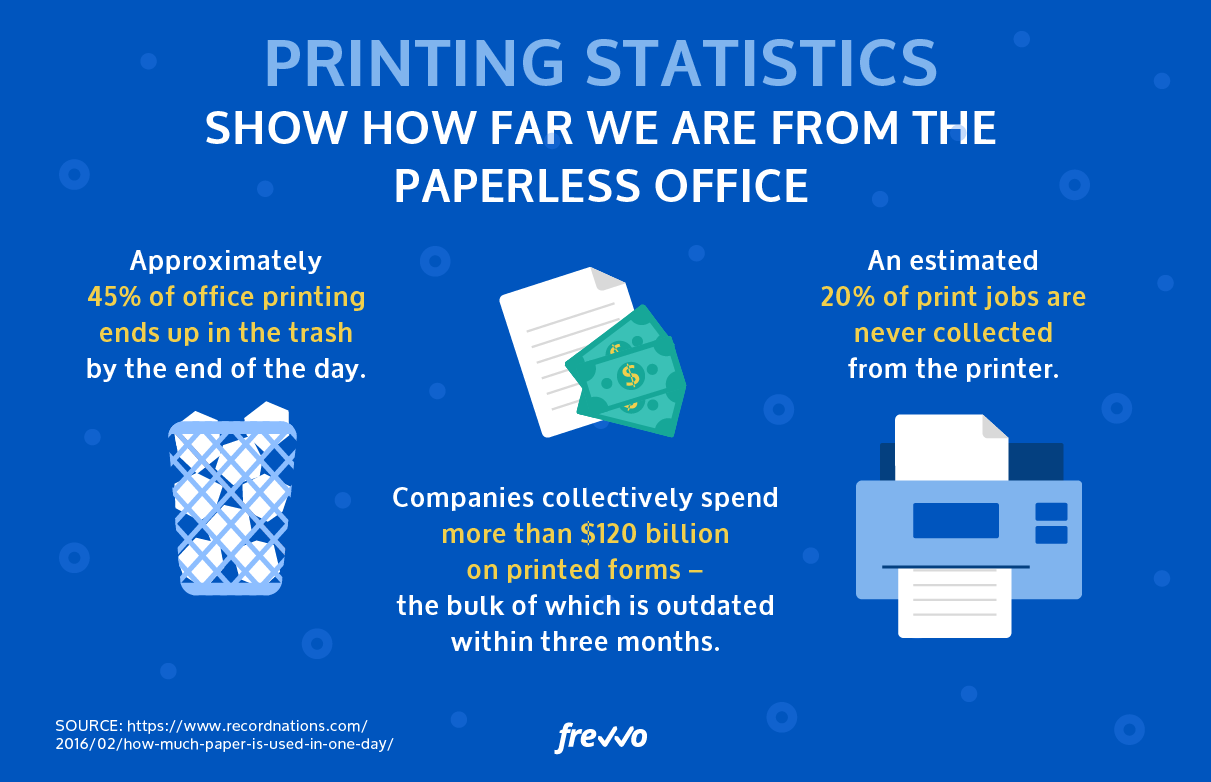In 1975, a Business Week article titled “The Office of the Future” predicted the rise of the paperless office. The concept arose as a publicist’s slogan for the IBM 2260 in 1964, which proclaimed the computer terminal as the harbinger of the “office of the future.”
Back then, paper documents were kept in filing cabinets and storage boxes, and when items were misfiled, it could take weeks to track them down. Processes involving large numbers of people like university admissions and student registration generated mountains of paperwork, all of which had to be processed by hand.
It’s no wonder the dream of the paperless office captivated the popular imagination: the thought of being able to process – and locate – information within seconds had enormous appeal.
So what is a paperless office? Exactly what it sounds like: a work environment where paper usage is either wholly eliminated or greatly reduced by using digital formats instead.
With the rise of personal computers and office automation, the use of paper for tasks such as bookkeeping, record-keeping and sending memos would be made redundant, as everything could be stored and displayed on computers. Prolific paper users like schools and universities would use screens to teach students and even homework assignments and exams would eventually be conducted using computers.
However, while Business Week’s prediction of a personal computer on every desk came true, the paperless office has not yet become a reality. Despite advances in communication technologies such as the advent of email, paper documents continued to proliferate.
The Motivation Behind the Paperless Office
While a number of factors contributed to the dream of the paperless office, the overriding consideration is the fact that organizations are under constant pressure to optimize business processes and resource usage.
Driving factors behind the paperless office concept include
- Cost savings,
- Increased technological capabilities,
- Easier remote collaboration,
- Better document management and less time searching for files,
- Greater convenience and efficiency,
- Environmental considerations,
- Easier onboarding and other HR processes,
- The ability to offer a better customer experience,
- More transparent and efficient finance processes,
- Greater document security,
- More complete “paper trails,” and
- Tidier offices
Why the Paperless Office Never Happened
In the 1980s there was a short-lived reduction in the amount of paper used as businesses began to transition to electronic documents, but this didn’t last long.
So why was the dream of the paperless office never realized? Why did MIT publish a book titled The Myth of the Paperless Office in 2001?
It turns out there’s more than one reason.
Human Behavior: Habit
One reason the paperless office never truly manifested is simply the power of habit. Having grown up with paper-based everything, office workers found it difficult to transition to only reading from screens, continuing to take notes by hand, for example; and printing reports to highlight or underline them, despite the fact that this can also be done on screen.
Another impediment to paperless office is the fact that despite the digitization of files and records, office workers are still struggling with digital document management. While it’s now theoretically possible to locate a file with a quick search, the problem is that people tend to be lax about naming files – not to mention remembering which folder that mysteriously-named file was saved in.
Legal Reasons
Even today, with the ubiquity of electronic signature services, for many organizations it’s still standard practice to require physical signatures on documents such as contracts and loan agreements.
(Initial) Unreliability of Computers
Early computers came with their fair share of problems. The average office worker found computers somewhat intimidating and didn’t really know how to use them, causing them to shy away from using them.
Simple tasks like running a slide show through a projector still present problems to many people to this day, resulting in them printing out presentations and accompanying documents – just in case of technical difficulties.
Early computers also crashed frequently, further compounding this problem. When data wasn’t saved on time – or “backed up” on paper, progress could be lost, resulting in work needing to be redone. Additionally, early systems did not integrate well with one another.
Trust Issues
Online banking didn’t really take off until fairly recently, largely due to the fact that many people were skeptical about the safety of accessing their bank accounts via the internet. As a result, many financial processes such as transfers were needlessly performed in-branch, continuing to use paper. With today’s cybersecurity measures, these fears are starting to subside and digital banking is rapidly becoming the norm.
Lack of Infrastructure
Until fairly recently, universities and other institutions required that applications and other administrative forms be submitted in hard copy, in part because they didn’t have the infrastructure in place to process these documents digitally. SaaS companies that provide digital ecosystems for document management and workflow automation simply weren’t around.
Printing and Copying Became Cheap
Improvements in printers and photocopiers made it easier and cheaper than ever before to produce paper documents, so counter to predictions, office paper usage more than doubled between 1980 and 2000.
Since 2000, it seems that office paper use has been in steady decline. Younger generations, in particular, are reluctant to print documents they can read on their screens. However, according to the Environmental Protection Agency, the average office worker used approximately two pounds (0.9kg) of paper and paper products per day in 2012.

New Technology Driving Momentum
While it’s taken 35 years to make any real progress, it seems like the tide is finally turning on office paper use. As technology has improved and become more affordable – and more secure – attitudes have changed. With the advent of cloud-based storage and collaboration tools, not to mention workflow automation tools, digital-first solutions are increasingly popular.
A new generation of workers (millennials) grew up with word processing, email, and the internet, as well as more recent advances such as tablets and smartphones. This generation has come of age in a world where screens are everywhere and can be used for just about everything.
With improved user design, reading and collaborating virtually is becoming increasingly comfortable. Moreover, the convenience of collaborating live on cloud-based platforms that offer versioning is very appealing, compared to printed documents that become outdated as soon as someone makes a change.
These days, it’s possible to generate dynamic digital forms that automatically feed into databases, streamline processes such as those involved in accounting, and automate workflows such as approval routing on purchase orders and travel requests – all without using a single piece of paper.
As awareness of the possibilities of integrating various systems grows and digital signatures gain wider credibility, paper use will likely decline further, particularly in light of renewed pressure on the business sector to reduce its environmental impact.
The Bank of America cut its paper usage by 25% in two years by embracing online forms and reports and making small changes like using lightweight paper and printing double-sided.
While it seems unlikely that paper will truly disappear from most offices any time soon, the proliferation of hardware and the growing ease of integrating various systems makes it likely that paper use will drop significantly in coming years.
Case Study: Cutting Paper Use in Higher Education with RPA
Adelaide Australia’s Flinders University implemented robotic process automation (RPA) to streamline its process for identifying which students qualify for commendation letters recognizing their academic performance.
The process, which runs three times per year, involves evaluating some 24,000 students for eligibility, using more 20,000 pages of academic transcripts and manually updating some 17,000 student records, as well as preparing and sending the letters. The process reportedly involved 45 manual steps and countless human hours.
In 2018, the university’s business innovation unit identified three data entry processes in the student management system that could be automated to streamline the commendation letter process, namely attaching a comment to student transcripts, generating the actual letters, and “flagging each topic used to calculate the GPA for recipients so that they cannot be used in future eligibility processes.”
The university was able to move from proof of concept to successful execution in the space of four months, saving more than 20,000 A4 pages per year as well as hundreds of hours of data entry.
How to Convert to a Paperless Office
By implementing digital solutions like accounting software, expense-tracking and human resources apps can help you to transition to a paperless office. Moreover, by integrating and automating these various workflows, you can significantly increase operational efficiency – and job satisfaction. Formerly paper-based processes can now be processed in seconds rather than days.
Here are a few tips to help you transition to a paperless office.
Adopt Paperless Business Processes
Ask yourself which kinds of paper documents are common in your business. Forms? Handouts? Expense tracking? Accounting? Reports? Research? Attendance tracking?
Perform an audit to identify the processes that use the most paper, and do a step-by-step analysis to identify areas where you can implement digitization and automation to reduce your reliance on paper and improve your organizational capabilities.
Change Your Culture
While technology is an important part of going paperless, it’s not enough. You need to create a culture of change in your organization by implementing company policies and enforcing them throughout your organizational structure, from the top down.
Get your team involved and foster a culture of innovation. Ask for platform and tool suggestions that could help make it easier to transition away from dependence on paper. Encourage feedback throughout the process. Your team will have to use the system you implement, so you’ll want to be sure they feel confident they can succeed.
Digitize Everything
Implementing an enterprise document management workflow can help organize your scanned documents and integrate the information they contain into your business’s processes as needed. Smart software can even help you extract even handwritten information from scanned documents, while automation software like frevvo can automatically plug this information into your accounting software or SQL database.
Use Online Applications for File-Sharing and Storage
Cloud-based applications like Google Apps, Evernote, and Basecamp, makes data sharing and collaboration easy, while tools like Dropbox allow for storing and sharing large files. These tools can also be easily integrated with your other business process tools using a simple workflow management tool.
Embrace Electronic Signatures
Switch to digital when collecting signatures. When collected correctly, electronic signatures have the same legal standing as a pen-on-paper signature. Instead of printing paper contracts only to scan and discard them as soon as they’re signed is incredibly wasteful. An e-signature solution is convenient, secure, and cost-effective.
Replace Paper Forms With Digital Forms
Any form you can imagine can be digitized, offering substantial benefits beyond cutting paper consumption. With dynamic forms, fields can update in response to the input, and even prefill with existing information from your database, saving employees from repetitive data entry. Using a form builder like frevvo’s easy-to-use dynamic form builder allows you to easily automate workflows, which can significantly impact efficiency and productivity.


